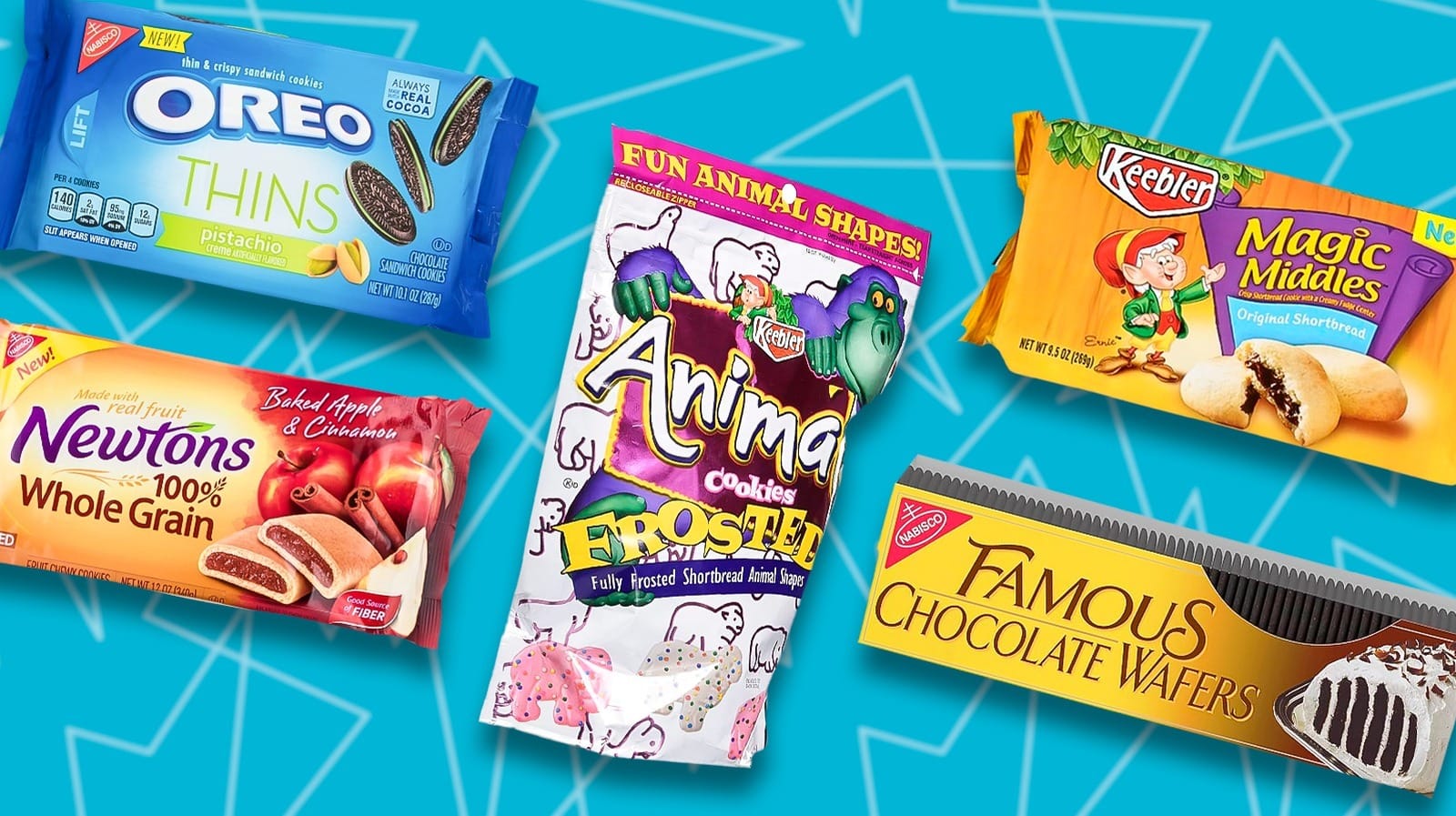Time has a peculiar way of erasing the simple pleasures that once brought joy to countless people. In the world of snacking, few things evoke nostalgia quite like the memory of a cherished biscuit that disappeared from shop shelves without fanfare. These culinary casualties represent more than just discontinued products—they embody childhood memories, teatime traditions, and the bittersweet reality of changing consumer preferences and corporate decisions.
The phenomenon of beloved food items vanishing from the market is neither new nor uncommon. Economic pressures, shifting consumer trends, manufacturing costs, and corporate restructuring often determine which products survive and which become mere memories. Yet for those who remember these treats, their absence creates a void that modern alternatives struggle to fill.
The Sweet Tragedy of Gypsy Creams
McVitie’s Gypsy Creams stood as one of the most lamented casualties in the biscuit world, particularly mourning their loss throughout the 1970s and beyond. These buttery, crispy delights featured a distinctive sandwich construction with a rich buttercream filling nestled between two golden biscuits. The texture was perfectly balanced—crisp enough to provide satisfying crunch, yet tender enough to melt pleasantly on the tongue.
What made Gypsy Creams particularly special was their versatility. They served admirably as afternoon tea companions, dunking beautifully in hot beverages without falling apart too quickly. The buttercream center provided just the right amount of sweetness without being cloying, making them appealing to both children and adults. Their golden-brown appearance and consistent quality made them a staple in biscuit tins across households.
The discontinuation of Gypsy Creams in 2005 marked the end of an era for McVitie’s and loyal consumers alike. While recipes exist online for home baking enthusiasts attempting to recreate these beloved treats, commercial production ceased permanently. Other countries had variations featuring chocolate and coconut biscuits held together by chocolate buttercream, but the classic British version remains irreplaceable.
The impact of losing Gypsy Creams extends beyond mere nostalgia. These biscuits represented a particular style of confectionery craftsmanship that emphasized balance between texture and flavor. Their disappearance reflects broader changes in the biscuit industry, where manufacturing efficiency and profit margins increasingly influence product portfolios over traditional recipes and loyal customer bases.
Cadbury Milk Bikis: The Cream-Filled Wonder
Cadbury Milk Bikis occupied a special place in the hearts of snack enthusiasts, particularly during the 1990s and early 2000s. These soft, cream-filled biscuits offered a delightful combination of mild chocolate flavor and smooth vanilla cream filling. Unlike many contemporary sandwich biscuits, Milk Bikis possessed a uniquely tender texture that practically melted in the mouth, creating an almost cake-like eating experience.
The ritual surrounding Milk Bikis consumption became as important as the taste itself. Children would carefully separate the two biscuit halves, savoring the cream filling first before enjoying the soft cookie portions. This interactive eating experience made them particularly popular in school lunchboxes and family gatherings, where the anticipation of opening a fresh pack created shared moments of enjoyment.
The gradual disappearance of Milk Bikis from mainstream retail channels represents a common pattern in the confectionery industry. While Britannia continues producing Milk Bikis under their brand, the original Cadbury version that many remember seems to have quietly faded from prominence. Recent reports suggest these biscuits have become increasingly difficult to find in regular stores, relegating them to specialty shops or online retailers.
Market dynamics played a significant role in Milk Bikis’ decline. The cream-filled biscuit segment became increasingly competitive, with larger brands investing heavily in marketing and distribution. Smaller or niche products like Milk Bikis struggled to maintain shelf space against more aggressively promoted alternatives. Additionally, changing manufacturing costs and ingredient sourcing challenges may have made continued production economically unviable.
Fox’s Echo Bar: The Hybrid That Almost Made It
Fox’s Echo Bar represented an ambitious attempt to bridge the gap between biscuits and chocolate bars when it launched in 2000. This innovative treat featured a finger of bubbly white chocolate sitting atop a biscuit base, with the entire creation enrobed in smooth milk chocolate. The concept aimed to compete directly with established favorites like KitKat and Twix, offering a unique textural experience that combined crispy biscuit crunch with creamy chocolate indulgence.
The Echo Bar’s design was thoughtfully executed, providing multiple textures and flavors in each bite. The biscuit base offered structural integrity and a satisfying crunch, while the bubbly white chocolate layer added sweetness and visual appeal. The milk chocolate coating brought everything together, creating a harmonious blend that many consumers found irresistible. Marketing positioned it as the perfect snack for those seeking something more substantial than a simple biscuit but less heavy than a full chocolate bar.
Despite developing a devoted following, Echo Bar faced discontinuation around 2012, much to the dismay of its fans. More than 600 people supported a petition calling for its return, demonstrating the genuine affection consumers held for this product. The passionate response highlighted how certain discontinued items develop cult-like followings, with memories of their unique taste and texture becoming increasingly precious over time.
Fox’s confirmed there are no plans to revive the Echo Bar, citing various business considerations. The decision likely involved factors such as production costs, market positioning, and the need to focus resources on more profitable product lines. This represents a common corporate dilemma where beloved products with smaller market shares become casualties of efficiency-driven business strategies.
Café Noir: The Coffee Lover’s Dream
Café Noir biscuits represented the perfect marriage of coffee culture and biscuit tradition, designed specifically for those who appreciated sophisticated flavors in their snacking choices. These crunchy, coffee-flavored biscuits featured distinctive coffee icing that delivered an authentic espresso-like taste experience. McVitie’s created them as premium offerings targeting adult consumers who sought more complex flavor profiles than traditional sweet biscuits provided.
The coffee flavor in Café Noir was notably authentic, avoiding the artificial taste that plagued many coffee-flavored snacks. The biscuits themselves had a satisfying crunch that complemented the rich coffee icing, creating a textural contrast that enhanced the overall eating experience. They served as ideal accompaniments to actual coffee, creating a double dose of caffeine-inspired pleasure that coffee enthusiasts particularly appreciated.
While reports suggest Café Noir has been discontinued, their status remains somewhat ambiguous. Some sources indicate they can still be found through determined searching, though they’re significantly rarer than they once were. This liminal status—neither fully available nor completely extinct—makes them particularly frustrating for fans who remember their distinct appeal.
The challenge with specialty flavored biscuits like Café Noir lies in their limited target audience. While coffee lovers appreciated their authentic taste, the broader market often preferred more conventional flavors. This specialized appeal, while creating devoted fans, may not have generated sufficient sales volume to justify continued production costs and marketing investment.
Sports Biscuits: The Athletic Achievement Awards
Sports Biscuits hold a unique position in biscuit history, combining snacking pleasure with athletic inspiration through their distinctive sports-themed designs. Originally launched in 1971 by Elkes, these shortbread treats featured detailed impressions of various sporting activities, from traditional pursuits like football and cricket to more contemporary additions like skateboarding and netball. Each biscuit became a small celebration of athletic achievement, making snack time more engaging and interactive.
The cultural impact of Sports Biscuits extended far beyond their taste, though the shortbread recipe provided a buttery, crumbly texture that satisfied traditional biscuit expectations. Children would collect and trade different sporting designs, creating a sense of excitement around each pack’s contents. This gamification element made Sports Biscuits particularly memorable, as they transformed ordinary snacking into a discovery experience.
The discontinuation of Sports Biscuits in June 2022 following Elkes’ acquisition sparked what was described as an “online feeding frenzy” when they were briefly reintroduced. Some enterprising individuals purchased bulk quantities to resell on auction websites, demonstrating the intense demand that still exists for these beloved treats. This market response highlighted how discontinuation can actually increase a product’s desirability and cultural significance.
Recognizing this demand, Elkes invested £1 million in new machinery to bring Sports Biscuits back to shelves at Aldi and Farm Foods stores. The resurrection story provides hope that consumer passion can sometimes overcome corporate decisions, though it also demonstrates how discontinuation and revival can become part of a product’s marketing narrative.
Horlicks Nutribic: The Health-Conscious Hybrid
Horlicks Nutribic represented an ambitious attempt by GSK to extend the trusted Horlicks brand into the biscuit category, targeting health-conscious consumers seeking nutritious snacking options. These biscuits aimed to combine the nutritional reputation of Horlicks with the convenience and appeal of baked goods. The concept seemed logical—leveraging a strong health drink brand to enter the increasingly competitive healthy snacking market.
However, Nutribic faced immediate legal challenges from Britannia Industries, who alleged trademark and copyright violations of their NutriChoice brand. The Madras High Court issued an interim order restraining GSK from manufacturing and selling Nutribic biscuits, citing similarities in packaging style, color scheme, and trade dress. This legal battle effectively ended Nutribic’s market presence before it could establish itself among consumers.
The Nutribic saga illustrates the complex intellectual property landscape in the food industry, where established brands must navigate carefully around existing trademarks and design patents. It also demonstrates how legal challenges can quickly derail promising product launches, regardless of their potential market appeal or consumer benefit.
Beyond legal issues, Nutribic’s failure reflects broader challenges in brand extension strategies. While the Horlicks name carried significant health credentials, translating those associations into a different product category proved more complex than anticipated. Consumer acceptance of health-positioned biscuits requires careful balance between nutritional benefits and taste satisfaction.
Tiger Biscuits: The Disputed Brand
Tiger Biscuits occupy a unique position in discontinued product history due to their involvement in corporate disputes and international trademark battles. Originally launched by Britannia in 1997, Tiger became the company’s largest brand within its first year, demonstrating remarkable market acceptance and consumer appeal. These glucose biscuits were specifically designed to provide energy and nutrition, particularly targeting children and active individuals.
The success of Tiger Biscuits was undeniable—they constituted 50% of Britannia’s market share in the organized biscuit sector and became a household name across India. Their popularity stemmed from effective marketing, competitive pricing, and genuine consumer satisfaction with both taste and perceived nutritional benefits. Celebrity endorsements, including appearances by Bollywood stars, further elevated the brand’s profile and cultural significance.
However, Tiger’s success became complicated by ownership disputes between Britannia’s joint venture partners, the Wadia Group and French company Danone. The conflict arose when it was discovered that Danone had registered the Tiger trademark in 70 countries without proper board approval, potentially compromising Britannia’s control over its most valuable brand. This legal battle highlighted the complex relationship between joint venture partners and the importance of clear intellectual property agreements.
The Tiger brand dispute was eventually resolved with Danone returning the trademark to Britannia, but the controversy demonstrated how successful products can become pawns in larger corporate conflicts. While Tiger biscuits continue to be available in some markets, their availability has become inconsistent, making them hard to find in many regions where they were once ubiquitous.
The Economics of Nostalgia
The disappearance of beloved biscuit brands reflects broader economic realities that govern the food industry. Manufacturing costs, ingredient sourcing, distribution challenges, and profit margin pressures all influence corporate decisions about product continuity. Many discontinued biscuits fell victim to efficiency drives aimed at streamlining product portfolios and focusing resources on higher-volume items.
Consumer behavior also plays a crucial role in product survival. While passionate fans may mourn discontinued favorites, their purchasing patterns often tell a different story. Nostalgia doesn’t always translate into sustained sales volumes, particularly when competing against heavily marketed alternatives or newer flavor innovations. Companies must balance emotional attachment against commercial viability when making discontinuation decisions.
The rise of social media has amplified voices calling for product returns, as demonstrated by numerous online petitions and campaigns for discontinued favorites. These digital movements showcase genuine consumer passion but don’t always reflect market realities. The gap between vocal advocacy and actual purchasing behavior creates challenges for companies considering product revivals.
| Biscuit Brand | Original Manufacturer | Discontinuation Year | Current Status |
|---|---|---|---|
| Gypsy Creams | McVitie’s | 2005 | Permanently discontinued |
| Milk Bikis (Cadbury) | Cadbury | Variable by region | Hard to find |
| Fox’s Echo Bar | Fox’s Biscuits | 2012 | Discontinued |
| Café Noir | McVitie’s | Disputed | Rare availability |
| Sports Biscuits | Elkes | 2022 | Recently revived |
| Horlicks Nutribic | GSK | 2012 | Legally discontinued |
| Tiger Biscuits | Britannia | Variable by region | Limited availability |
The Cultural Impact of Lost Flavors
Discontinued biscuits represent more than commercial casualties—they embody cultural memories and shared experiences that helped define particular time periods and social contexts. These products often served as bridges between generations, with grandparents introducing grandchildren to favorites from their own youth. Their disappearance creates gaps in cultural continuity that newer products struggle to fill.
The ritualistic aspects of consuming certain biscuits added layers of meaning beyond simple nutrition or pleasure. The careful separation of Milk Bikis halves, the collection and trading of Sports Biscuits designs, or the sophisticated appreciation of Café Noir’s coffee notes created structured experiences that enhanced their memorability. Modern alternatives may taste similar but lack these embedded cultural practices.
Regional variations and local preferences also influenced which biscuits achieved iconic status in different markets. Products that dominated British teatime culture differed from those popular in Indian households or Australian lunch boxes. These geographic specificities make discontinued items particularly poignant for displaced populations who associate certain flavors with homeland memories.
The democratizing nature of biscuits—affordable luxuries accessible across socioeconomic boundaries—meant that discontinued favorites often represented shared experiences across diverse communities. Unlike expensive delicacies that remained exclusive, these mass-market treats created common ground and collective memories that transcended traditional social divisions.
Manufacturing Challenges and Quality Compromises
The complexity of maintaining consistent quality while controlling costs posed ongoing challenges for biscuit manufacturers. Many discontinued products fell victim to reformulations aimed at reducing expenses, with ingredients substitutions or process changes compromising the taste and texture that made them special. Consumer loyalty proved fragile when faced with perceptibly inferior versions of beloved products.
Regulatory changes also impacted product viability, particularly regarding trans fats, artificial colors, and preservative restrictions. Some biscuits couldn’t be reformulated successfully within new regulatory frameworks while maintaining their distinctive characteristics. Rather than releasing inferior versions, manufacturers sometimes chose discontinuation as the more honorable option.
Supply chain disruptions and ingredient availability fluctuations created additional pressures. Specialty flavorings, particular wheat varieties, or specific processing equipment might become unavailable or prohibitively expensive. These operational challenges often remained invisible to consumers but significantly impacted manufacturers’ ability to maintain consistent production.
The consolidation of retail distribution channels also influenced product survival. As major supermarket chains gained power, they demanded better terms and focused shelf space on high-turnover items. Specialty or niche biscuits found themselves squeezed out by more aggressive competitors or private label alternatives, regardless of consumer affection.
The Psychology of Food Memory
The emotional connections people form with particular foods during childhood create lasting preferences that persist throughout life. Discontinued biscuits trigger these deep-seated associations, often evoking memories of specific people, places, or circumstances surrounding their consumption. This psychological dimension explains why certain discontinued items generate such passionate advocacy years after their disappearance.
Taste memory proves remarkably durable, with people accurately recalling flavor profiles and textures decades after last experiencing them. These vivid recollections often exceed reality, as remembered tastes become idealized through time and emotional association. Attempts to recreate discontinued favorites frequently disappoint because they compete against enhanced memories rather than actual historical products.
The scarcity created by discontinuation paradoxically increases desirability. Items that were once commonplace become precious when unavailable, with their absence creating a sense of loss that their original presence never generated. This scarcity psychology explains why brief returns or limited availability of discontinued products often generate disproportionate excitement and purchasing activity.
Social bonding around shared food memories creates communities of nostalgia that keep discontinued products alive in collective consciousness. Online forums, social media groups, and recipe-sharing communities maintain these connections, ensuring that discontinued favorites remain part of ongoing cultural conversations rather than fading into complete obscurity.
Modern Alternatives and Recipe Recreation
The internet age has enabled unprecedented sharing of homemade recreation attempts for discontinued favorites. Food bloggers, recipe developers, and passionate fans regularly publish detailed instructions for recreating lost biscuits, often after extensive experimentation with ingredients and techniques. These efforts demonstrate both the enduring appeal of discontinued products and the challenges involved in matching commercial production methods.
Home baking limitations mean that recreated versions rarely achieve identical results to original commercial products. Professional manufacturing equipment, specialized ingredients, and optimized processes created textures and flavors that domestic kitchens struggle to replicate exactly. However, homemade versions often provide satisfying approximations that help address nostalgic cravings.
Some artisanal bakeries and specialty food companies have built business models around producing updated versions of discontinued classics. These small-scale operations can serve niche markets that major manufacturers abandoned, though higher prices and limited distribution restrict their reach. They represent compromise solutions that honor original concepts while adapting to contemporary market realities.
The rise of crowdsourcing and social media has also enabled coordinated campaigns to pressure manufacturers for product returns. While success rates remain low, occasional victories like the Sports Biscuits revival demonstrate that sustained consumer advocacy can sometimes overcome corporate resistance to reviving discontinued products.
The story of forgotten biscuits serves as a microcosm of broader changes in consumer culture, manufacturing economics, and collective memory. These humble snacks carried significance far beyond their nutritional value, serving as vehicles for social connection, childhood comfort, and cultural identity. Their disappearance reflects not just business decisions but the ongoing transformation of how we produce, market, and remember the foods that shape our lives.
While new products continue emerging to satisfy contemporary tastes and preferences, the gap left by discontinued favorites remains unfilled for those who remember them. These lost flavors remind us that progress doesn’t always mean improvement, and that some pleasures, once lost, prove irreplaceable. The continuing passion for these vanished treats ensures they remain alive in memory, even when absent from shop shelves.
The economics of food production will continue evolving, likely claiming more beloved products as casualties of changing markets and corporate priorities. Yet the stories of these seven forgotten biscuits demonstrate that true favorites never completely disappear—they live on in the memories of those who loved them, in the recipes of those who attempt to recreate them, and in the hope that someday, against commercial logic, they might return to bring joy once more.









Leave a Comment